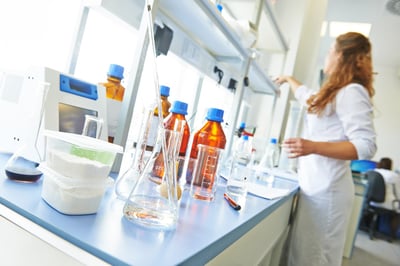3 Proactive Steps to Preserve Laboratory Worker Safety
 Laboratory environments are generally staffed with highly knowledgeable and competent staff. But even the best of the best have accidents from time to time.
Laboratory environments are generally staffed with highly knowledgeable and competent staff. But even the best of the best have accidents from time to time.
There are some simple steps to take to prevent as many accidents as possible, but a great safety plan always has a contingency system in place for those times when something does go awry.
Here are the best steps for protecting the safety of your laboratory workers before, during, and after the sounding of your panic alarm system.
1. Train All Workers (and Retrain Regularly)
Just because an employee is used to working with certain substances or materials doesn't mean they're adapted to your particular processes and setup. All workers need to be initiated into the laboratory setting with the proper training.
Teach them about your protocols, what types of safety processes, procedures, gear, and equipment you have in use, and how to use those. Don't assume they know anything. Train as if it's the first time they've ever heard it. Also, retrain regularly. It's human nature to become adapted to your workplace environment, which leads to paying less attention to what you're doing, potentially leading to an accident. Sidestep this tendency to become lax with the rules and equipment by refreshing their training regularly and imposing penalties for workers who fail to use proper procedures and equipment.
2. Provide the Proper Safety Gear & Equipment
Naturally, if you don't have the right equipment on hand, it's impossible to enforce policies that workers use it. The equipment and gear you need depends on the materials and substances being worked with, but all laboratories need safety measures like protective clothing, including plenty of extras so that workers can change if their clothes become soiled with something toxic, flammable, or otherwise dangerous. Protective goggles and gloves are also essential, along with fire extinguishers that are rated for the chemicals commonly found in your lab. Check the extinguishers regularly, as these do need replacing from time to time. Also provide eye wash stations and areas where workers can hose off dangerous chemicals, if needed. OSHA is a great resource for recommendations when it comes to specific safeguards for particular laboratory environments.
3. Install the Best Panic Alarm System for the Environment
The panic alarm system is your safeguard when all of the other safety measures fail. Since labs are commonly staffed with lone workers, there are panic alarm systems available with features like Man Down and No Response. Man Down is a feature that alerts someone if a worker becomes prone, such as if they pass out or are knocked out. No Response is a feature that periodically pings a worker, and issues an alert automatically in the event that the worker does not respond within a reasonable period of time. Or, the panic alarm system can be triggered by pressing a button if a worker needs to summon help quickly. The alarm tells those responding to the incident exactly where the situation is and who's in trouble, so that they don't lose valuable response time searching for the dangerous situation.
Don't leave your lab workers unprotected any longer. Request a quote for the panic alarm system you need today.





